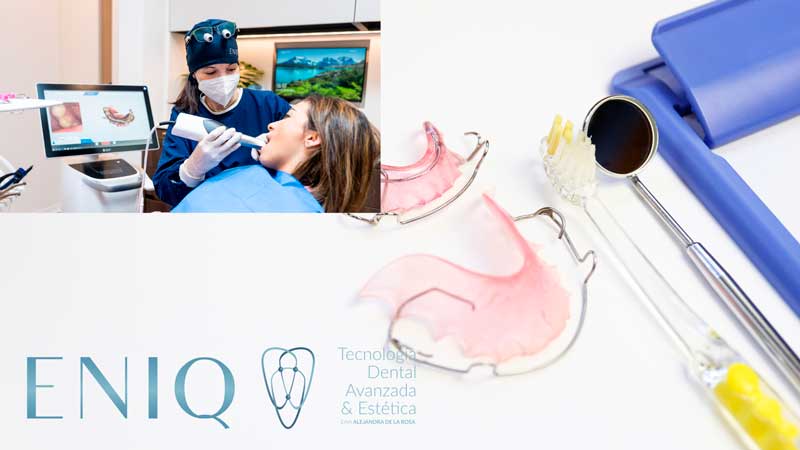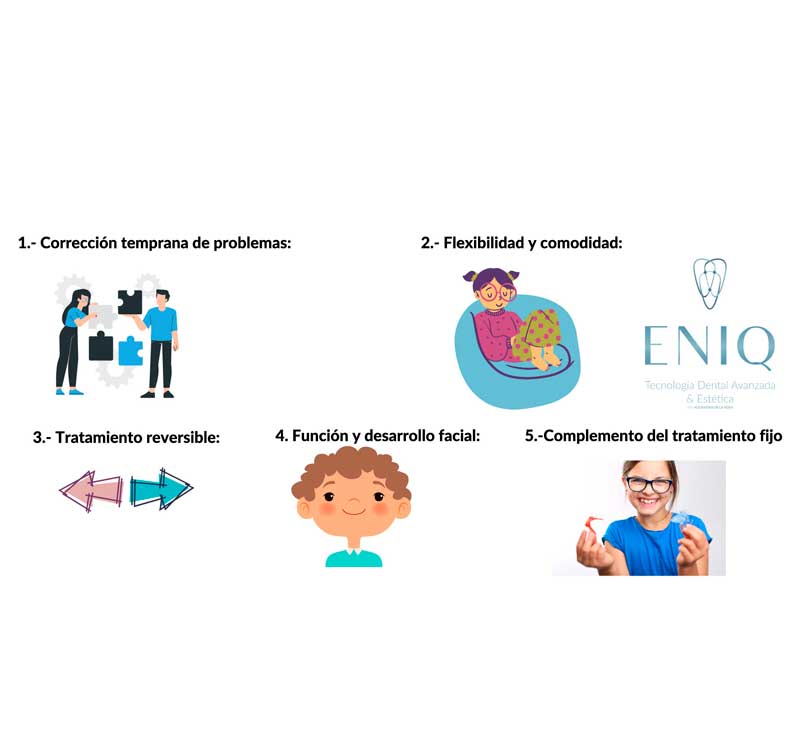

Appliances
We offer personalized solutions to align and beautify your smile.
What Are Interceptive or Functional Appliances in Orthodontics?
Interceptive or functional appliance therapy in orthodontics refers to a set of devices and appliances used to correct malocclusion and jaw development issues in growing children. These appliances aim to influence the growth and position of the jaws as well as the alignment of teeth to achieve better occlusion and proper oral function.
Interceptive appliance therapy is typically used in patients in the early stages of growth, when the bones and facial tissues are still developing and more malleable. Interceptive treatment aims to correct skeletal and dental anomalies before they become more severe and challenging to address in later stages.
Some examples of interceptive or functional appliances include palatal expanders, mandibular advancement appliances, muscular activators, functional retainers, and intermaxillary elastics. These appliances apply gentle and controlled forces on teeth and bones to guide the growth and position of the jaws, improve the relationship between the upper and lower jaw, and correct tooth positioning.
It's important to note that interceptive appliance therapy in orthodontics is part of a multidisciplinary approach, which may involve collaboration between orthodontists, maxillofacial orthopedists, and other dental specialists. The primary goal is to achieve functional occlusion, proper facial aesthetics, and overall oral health improvement. Each patient is individually assessed to determine the most suitable functional appliance based on their specific needs.
What Are the Steps in the Interceptive Appliance Therapy Procedure in Orthodontics?
The procedure for interceptive appliance therapy in orthodontics may vary depending on the case, following these general steps:
- Evaluation and Diagnosis: Comprehensive evaluation by the orthodontist, using X-rays, photographs, and dental models for a detailed diagnosis and to determine the need for interceptive appliances.
- Treatment Plan Design: Creation of a personalized treatment plan, selecting the appropriate appliances, estimating the treatment duration, and setting clear objectives.
- Appliance Placement: Cementation of brackets, placement of bands, or adaptation of removable appliances in the patient's mouth.
- Adjustments and Follow-up: Regular appointments for adjustments and progress monitoring, including spring activation or wire modifications.
- Treatment Completion: Removal of the interceptive appliance upon achieving treatment goals, with possible additional orthodontic treatment for complete alignment.
Customization of treatment for each patient, adherence to the orthodontist's instructions, and attendance at all appointments are crucial to achieve the best results.

Important
What Is the Importance of Removable Orthodontic Appliances?
Removable orthodontic appliances play a significant role in orthodontic treatment for several reasons:

- Early Problem Correction: Removable appliances are especially useful in young patients whose jaws and teeth are still developing. These appliances allow for addressing malocclusion and jaw development issues at early stages when it's easier to correct them and prevent them from becoming more severe.
- Flexibility and Comfort: Removable appliances can be taken out by the patient, making oral hygiene easier and allowing for more comfortable eating and speaking. This means that the patient can maintain good oral health during treatment and lead a more normal daily life.
- Reversible Treatment: In many cases, removable appliances allow for a reversible treatment approach. This means that if the results are not as expected or if changes occur in the treatment plan, the orthodontist can adjust or change the appliance relatively easily. This offers greater flexibility and allows for adapting the treatment as it progresses.
- Function and Facial Development: Some removable appliances, such as functional retainers and muscular activators, not only correct tooth positions but also influence the growth and development of jaws and facial muscles. These appliances can improve bite function, long-term result stability, and overall facial aesthetics.
- Complement to Fixed Treatment: In many cases, removable appliances are used as part of a combined treatment plan, alongside fixed appliances like braces. Removable appliances can help prepare teeth and jaws before the placement of fixed appliances, expedite the alignment process, or make specific adjustments during different stages of treatment.
It's important to highlight that the effectiveness of removable appliances depends on the patient's compliance and consistency in using them. Following the orthodontist's instructions and using the appliance regularly and properly is essential to achieve the desired results.

What Are the Types of Removable Appliances or Interceptive Orthodontics for Children?
There are several types of removable appliances used in interceptive orthodontics for children. Below, I'll mention some of the most common ones:
- Active or flat plates: These appliances consist of an acrylic plate that covers the palate or upper jaw and rests on the posterior teeth. They may have elements like expansion screws, springs, or hooks to apply specific forces and correct malocclusions such as crossbite or excessive overjet.
- Palatal expanders: These appliances are used to correct narrowing of the upper jaw and expand the palate. These appliances have an expansion screw in the center that is gradually activated to apply expanding forces on the palate.
- Muscular or functional activators: These appliances are designed to correct growth and jaw position problems, as well as improve muscular function. They are usually placed on the palate and have elements like ramps, tracks, or balls that interact with the tongue and orofacial muscles, promoting proper jaw development and improving tooth position.
- Functional retainers: Also known as mandibular position appliances, these are used to correct deep bite, overbite, or mandibular retrognathia problems. These appliances have an acrylic plate on the palate and a metal structure that fits on the lower teeth to guide the jaw into a more favorable position.
- Space maintainers: These appliances are used to maintain space in the mouth when a baby tooth has been prematurely extracted or lost due to cavities or trauma. Space maintainers prevent neighboring teeth from shifting and occupying the space before permanent teeth erupt.
It's important to note that the choice of removable appliance depends on the diagnosis and specific needs of each patient. The orthodontist will carefully assess each case to determine which type of appliance is most suitable and design a personalized treatment plan.
What Is the Right Choice: Fixed or Removable Interceptive Orthodontic Appliances?
An absolute "better" approach between fixed and removable interceptive orthodontic appliances cannot be determined, as the choice between fixed or removable interceptive appliances depends on various factors, such as the nature of the problem being treated, the patient's age, and the orthodontist's preferences.
Both approaches have their advantages and are used in different situations.
Fixed interceptive appliances:
- Greater control: Fixed appliances, like braces, allow for greater control over tooth and bone positions. They are more precise in making specific adjustments and achieving precise dental alignment.
- Constant use: Fixed appliances remain in place throughout the treatment, meaning the patient cannot remove them. This ensures a constant application of the necessary forces to correct dental problems.
- Greater correction capacity: Fixed appliances can address a wide range of malocclusion issues and allow for more comprehensive and detailed correction of tooth and jaw positions.
Removable interceptive appliances:
- Greater comfort and convenience: Removable appliances can be taken out by the patient for eating, brushing teeth, or in specific situations. This provides greater comfort and facilitates oral hygiene.
- Reversible treatment: Some removable appliances allow for simpler adjustments and modifications, making them more reversible compared to fixed appliances. This can be helpful if a change in the treatment plan is required.
- Muscular stimulation and facial development: Some functional removable appliances can help improve facial muscle development and jaw growth, in addition to correcting tooth positions.
The choice between fixed and removable interceptive appliances will depend on the assessment and diagnosis performed by the orthodontist, as well as the specific needs of the patient. The orthodontist will determine which approach is most suitable to achieve the treatment goals for each individual.
What are the benefits of undergoing dental implant treatment at Eniq?
The application of ENIQ technology in removable or functional orthodontic appliances can offer several advantages and improvements in the orthodontic treatment process. Some of the benefits of using technology in this type of appliances are:
- Customized design: 3D scanning technology and computer-aided design allow for the creation of removable or functional appliances that are more precise and personalized for each patient. This ensures a better fit and comfort, as well as greater effectiveness in applying the necessary forces to correct malocclusion.
- Increased treatment efficiency: Digital technology can expedite and enhance the appliance manufacturing process. Removable or functional appliances can be produced more quickly and efficiently, reducing the total treatment time and allowing for a quicker response to patient needs.
- Monitoring and progress tracking: Some removable or functional appliances may feature integrated sensors or tracking devices that enable orthodontists to monitor the usage and effectiveness of the appliance. This provides objective data on treatment progress and allows for precise adjustments if necessary.
- Patient education and motivation: Technology can help educate and motivate patients during treatment. Some removable appliances may include mobile applications or digital interfaces that provide information on treatment progress, usage reminders, and interactive exercises to enhance adherence and treatment effectiveness.
- Interdisciplinary collaboration: Digital technology facilitates collaboration among different dental specialists, such as orthodontists, maxillofacial orthopedists, and general dentists. Digital data and records can be easily shared, improving communication and treatment coordination among the professionals involved.
In summary, the integration of technology into removable or functional appliances can enhance the precision, efficiency, and patient experience during orthodontic treatment. However, it's important to note that the implementation of technology may vary depending on the clinic and the resources available in each specific case.
What is the cost of dental appliances?
The price of removable orthodontic appliances in Spain can vary considerably depending on several factors, such as the complexity of the case, geographical region, the reputation and experience of the orthodontist, and other costs associated with orthodontic treatment.
In general, the cost of removable appliances can range from 500 euros to 2,000 euros or more. However, it is important to note that this price range is approximate and can vary significantly. Some simpler cases may have a lower cost, while more complex cases or those requiring longer treatment may have a higher cost.
It is essential to consult directly with an orthodontist in Spain to obtain a comprehensive evaluation and an accurate quote for your specific case. The orthodontist can assess your needs and provide detailed information about costs and available financing options.
Interceptive Orthodontics
Dental Appliances
*subject to specialist evaluation
The cost of removable orthodontic appliances can range from 500 euros to 2,000 euros or more. However, it is important to note that this price range is approximate and can vary significantly.
-
All-inclusive
Frequently Asked Questions
Do you have more questions about dental appliances?
The duration of treatment with interceptive or functional orthodontic appliances can vary depending on various factors, including the patient's age, the nature of the problem being treated, and the individual response to treatment. In general, interceptive orthodontic appliances are used in early stages of growth when the bones and facial tissues are still developing and more pliable.
The treatment time with interceptive appliances can range from a few months to approximately two years. Some cases may require a shorter treatment time, especially when used to correct specific and limited issues. Other more complex cases or those with more severe problems may require a longer treatment time.
It is important to note that interceptive orthodontic appliances are often used as an initial phase of orthodontic treatment. After interceptive orthodontics, additional treatment with fixed orthodontics, such as braces, may be required to achieve complete dental alignment and reach the final treatment goals.
The exact duration of treatment will be determined by the orthodontist after evaluating the patient's specific case and designing a personalized treatment plan. During treatment, regular follow-up appointments will be scheduled to make adjustments to the appliance and monitor treatment progress. It is important to follow the orthodontist's instructions and attend all scheduled appointments to achieve the best results in the shortest possible time.
It is essential to maintain good oral hygiene during orthodontic treatment to prevent issues such as cavities and gingivitis. Here are some tips for caring for and cleaning your appliances:
- Regular brushing: Brush your teeth after every meal and before bedtime. Use a soft toothbrush and pay special attention to areas around the brackets and wires.
- Flossing: Use dental floss or an interdental cleaner to clean between your teeth and around the appliances, where the brush may not reach.
- Mouthwash: Rinse your mouth with a mouthwash recommended by your orthodontist to help eliminate bacteria and keep your breath fresh.
- Avoid sticky foods: Avoid sticky or hard foods that can damage the appliances or get stuck in them.
- Regular orthodontist visits: Schedule regular follow-up appointments with your orthodontist for adjustments and check-ups.
By following these care and hygiene guidelines, you will keep your dental appliances in good condition and maintain a healthy smile.
During orthodontic treatment with dental appliances, it is important to be mindful of what you eat to avoid damaging the appliances or complicating the process. Here are some recommendations:
- Avoid sticky foods: Avoid sticky candies, chewing gum, and foods that can get stuck in the brackets and wires.
- Hard foods: Reduce consumption of hard foods such as nuts and ice that can break the appliances.
- Cut foods into small pieces: If you want to eat crunchy foods, cut them into small pieces to prevent damage to the appliances.
- Balanced diet: Maintain a balanced diet rich in fruits, vegetables, and proteins to promote good oral health.
Your orthodontist will provide specific dietary guidelines during treatment. By following these recommendations, you can keep your dental appliances in good condition and ensure an effective treatment process.
Services
All rights reserved © ENIQ Clinic 2025
Legal Notice · Privacy Policy · Cookie Policy
